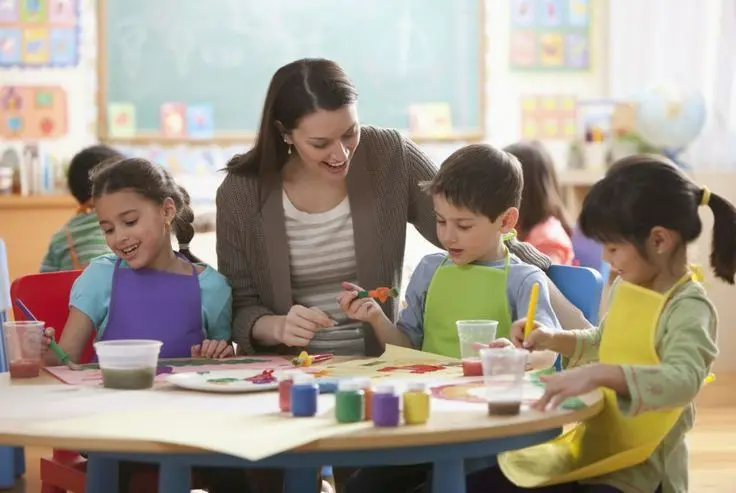Language and Literacy
Warm greetings to all the dedicated instructors involved in the Educational Resources for Language and Literacy program
Language and literacy are important methods that children use to elaborate, negotiate, and generate ideas. Having the ability to babble through storytelling, children develop connections with imagination as well as problem-solving skills. Creative thinking is developed when children are encouraged to utilize language to role-play and create stories, as well as create meaning by use of texts, symbols, and pictures. Literacy is not only reading and writing but also talking and listening, drawing and digital communication. The encouragement of language and literacy during early years not only promotes communication but also curiosity, trust, and innovation
Theories and Perspectives on Creativity in Art
- Vygotsky’s Sociocultural Theory: it emphasized the use of language in cognitive development processes of interaction and scaffolding.
- Reggio Emilia Approach: he takes a perspective of language being among the hundred languages that children can utilize in expressing themselves in creative ways. All these theories embrace the emergence of language and literacy happens to be through creative interactions (Nolan & Raban, 2024).
- Howard Gardner’s Multiple Intelligences: he is aware of the linguistic intelligence and interpersonal intelligence as the essential in the creativity of communication.
Resources, Materials, and Digital Technologies
- Physical resources: picture books, alphabet blocks and magnetic letters, story stones or story cubes, finger puppets, hand puppets, keyword or letter sound posters, hats, scarves, capes, labels, and word-cards in the classroom.
- Creative resources: drawing tools like markers, crayons, pencils, and whiteboards. Journals or mini books for children, use collage materials to make story characters, and templates of poetry or I am poem, art materials to make up puppets or props of stories, buttons, sticks, fabric, etc.
- Digital resources and technologies: Book Creator app to create books with photos, words, and sound, puppets, Pals, or Toontastic to tell stories in animation voice recorders, or microphones to record the storytelling of kids, smartboard or tablets.
Learning experiences by age group
- 0 to 2 years
- Book Exploration with textures: on sensory books have various textures and flaps are explored by the infants. Teachers call things, imitating sounds, and pose questions to expand the vocabulary and interest, including open-ended questions.
- Mirror Talk Time: Infants talk like they are in a mirror. Teachers model their speech and facial expression as a way of facilitating of early development of communication and self-awareness.
- 2 to 3 years
- Story Basket Play: They act on a themed basket, for instance, “going to the farm,” in which books, puppets, and props are touched upon. They retell and use objects and expressions.
- Talk table: place a table on which there are various things like shells, toy animals, and fabrics. It enables children to touch or see and be able to comment on these things by talking or using their body language. It will target vocabulary development, imaginative thinking, as well as social language.
- 3 to 5 years
- Daily message time: write a short message daily. Children take part in the reading aloud, letter identification, and word prediction using phonics ability clues.
- Post office play: pretend an imaginary post office. Children create drawings, compose messages, “stamp” them, and present them to their peers. Encouraging purposeful writing helps develop sequencing.
- 6 to 8 years
- Reader’s theatre: the children follow simple scripts and act out a story or a play. It helps them to develop confidence, expression.
- Word games and apps: play games like Scrabble or Boggle, or use literacy apps like Teach Your Monster to Read or Endless Alphabet to improve your spelling and vocabulary.
Original Creative Learning Opportunities
- Story basket play: I made a themed basket with books, puppets, and little accessories related to the farm excursion. Children read the book, manipulate the objects, and start telling the story. Some do animal sounds, and others point and discuss what they see. It is an important step towards vocabulary construction, telling stories and relating language with interests in the real world.
- Reader’s Theatre: I gave children a very short, very simple script based on things they’re familiar with. They read their lines to each other and do them themselves. This will enable them to feel more confident, fluent, and expressive. They are not only reading the words, but they are also taking into account the significance, voice, and character. It’s a neat method of bringing literature to life.
Critical thinking
Helping children develop their language literacy does not only mean that I teach a child to read and write, but also teaches them how to think critically. They make predictions, ask questions, and solve problems as they learn to make use of stories, conversation, and print. I observe how the children meditate on meaning, make connections between ideas, and share their own ideas in drawing, writing or telling stories. Even such simple things as discussing a picture or retelling a story provide them with opportunities to reason, compare, and imagine. All these examples of everyday experiences aid the development of children into complex, comprehend communicators that can use and comprehend language in a creative and meaningful manner.

https://pin.it/6hqBoggXK
Original Creative Learning Opportunities for Children


